
EmbodiedScan
[CVPR 2024] EmbodiedScan: A Holistic Multi-Modal 3D Perception Suite Towards Embodied AI
Stars: 412
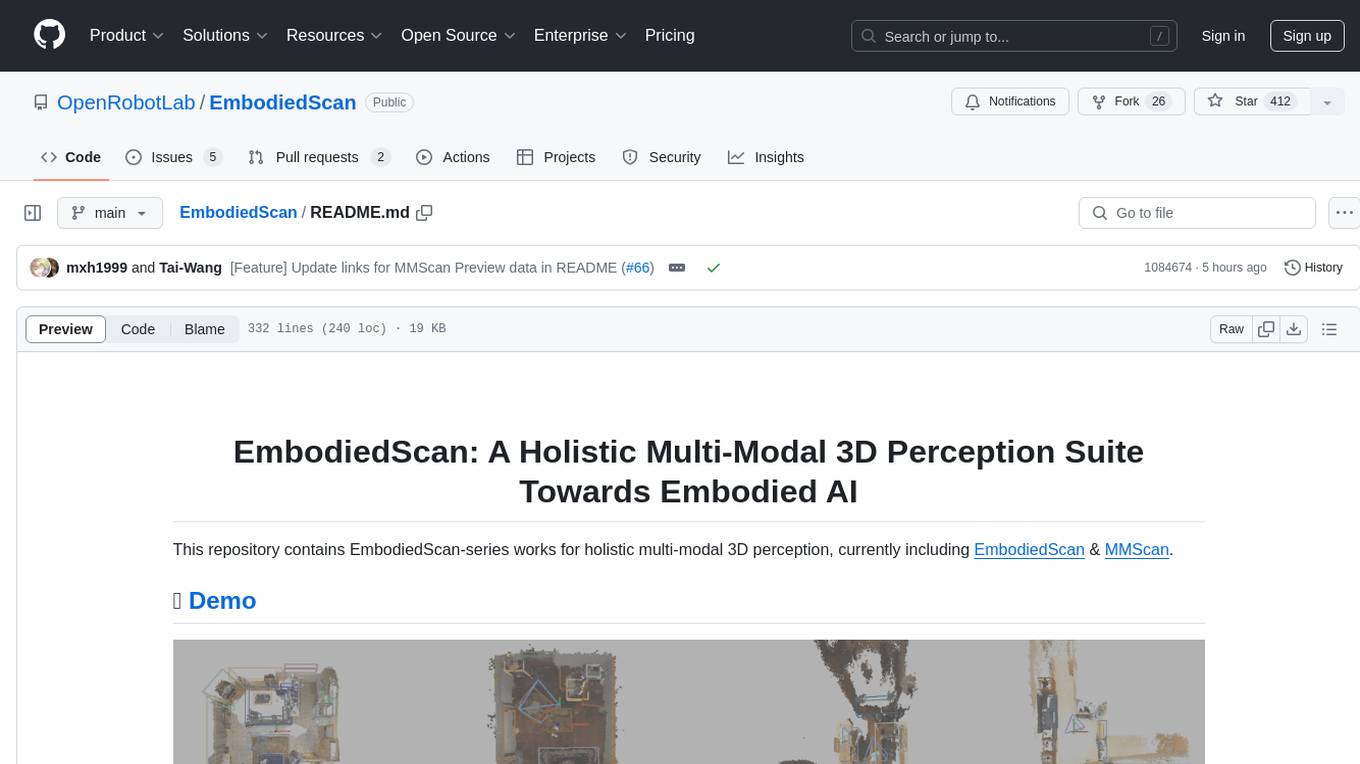
EmbodiedScan is a holistic multi-modal 3D perception suite designed for embodied AI. It introduces a multi-modal, ego-centric 3D perception dataset and benchmark for holistic 3D scene understanding. The dataset includes over 5k scans with 1M ego-centric RGB-D views, 1M language prompts, 160k 3D-oriented boxes spanning 760 categories, and dense semantic occupancy with 80 common categories. The suite includes a baseline framework named Embodied Perceptron, capable of processing multi-modal inputs for 3D perception tasks and language-grounded tasks.
README:
This repository contains EmbodiedScan-series works for holistic multi-modal 3D perception, currently including EmbodiedScan & MMScan.
🤖 Demo
- [2024-08] We preliminarily release the sample data of MMScan and the full release will be ready with ARKitScenes' annotations this month, which will be announced via emails to the community. Please stay tuned!
- [2024-06] The report of our follow-up work with the most-ever hierarchical grounded language annotations, MMScan, has been released. Welcome to talk with us about EmbodiedScan and MMScan at Seattle, CVPR 2024!
- [2024-04] We release all the baselines with pretrained models and logs. Welcome to try and play with them on our demo data! Note that we rename some keys in the multi-view 3D detection and visual grounding model. Please re-download the pretrained models if you just use our code for inference.
- [2024-03] The challenge test server is also online here. Looking forward to your strong submissions!
- [2024-03] We first release the data and baselines for the challenge. Please fill in the form to apply for downloading the data and try our baselines. Welcome any feedback!
- [2024-02] We will co-organize Autonomous Grand Challenge in CVPR 2024. Welcome to try the Multi-View 3D Visual Grounding track! We will release more details about the challenge with the baseline after the Chinese New Year.
- [2023-12] We release the paper of EmbodiedScan. Please check the webpage and view our demos!
We test our codes under the following environment:
- Ubuntu 20.04
- NVIDIA Driver: 525.147.05
- CUDA 12.0
- Python 3.8.18
- PyTorch 1.11.0+cu113
- PyTorch3D 0.7.2
- Clone this repository.
git clone https://github.com/OpenRobotLab/EmbodiedScan.git
cd EmbodiedScan- Create an environment and install PyTorch.
conda create -n embodiedscan python=3.8 -y # pytorch3d needs python>3.7
conda activate embodiedscan
# Install PyTorch, for example, install PyTorch 1.11.0 for CUDA 11.3
# For more information, please refer to https://pytorch.org/get-started/locally/
conda install pytorch==1.11.0 torchvision==0.12.0 torchaudio==0.11.0 cudatoolkit=11.3 -c pytorch- Install EmbodiedScan.
# We plan to make EmbodiedScan easier to install by "pip install EmbodiedScan".
# Please stay tuned for the future official release.
# Make sure you are under ./EmbodiedScan/
# This script will install the dependencies and EmbodiedScan package automatically.
# use [python install.py run] to install only the execution dependencies
# use [python install.py visual] to install only the visualization dependencies
python install.py all # install all the dependenciesNote: The automatic installation script make each step a subprocess and the related messages are only printed when the subprocess is finished or killed. Therefore, it is normal to seemingly hang when installing heavier packages, such as Mink Engine and PyTorch3D.
BTW, from our experience, it is easier to encounter problems when installing these two packages. Feel free to post your questions or suggestions during the installation procedure.
Please refer to the guide for downloading and organization.
We provide a simple tutorial here as a guideline for the basic analysis and visualization of our dataset. Welcome to try and post your suggestions!
We provide a demo for running EmbodiedScan's model on a sample scan. Please download the raw data from Google Drive or BaiduYun and refer to the notebook for more details.
Embodied Perceptron accepts RGB-D sequence with any number of views along with texts as multi-modal input. It uses classical encoders to extract features for each modality and adopts dense and isomorphic sparse fusion with corresponding decoders for different predictions. The 3D features integrated with the text feature can be further used for language-grounded understanding.We provide configs for different tasks here and you can run the train and test script in the tools folder for training and inference. For example, to train a multi-view 3D detection model with pytorch, just run:
# Single GPU training
python tools/train.py configs/detection/mv-det3d_8xb4_embodiedscan-3d-284class-9dof.py --work-dir=work_dirs/mv-3ddet
# Multiple GPU training
python tools/train.py configs/detection/mv-det3d_8xb4_embodiedscan-3d-284class-9dof.py --work-dir=work_dirs/mv-3ddet --launcher="pytorch"Or on the cluster with multiple machines, run the script with the slurm launcher following the sample script provided here.
NOTE: To run the multi-view 3D grounding experiments, please first download the 3D detection pretrained model to accelerate its training procedure. After downloading the detection checkpoint, please check the path used in the config, for example, the load_from here, is correct.
To inference and evaluate the model (e.g., the checkpoint work_dirs/mv-3ddet/epoch_12.pth), just run the test script:
# Single GPU testing
python tools/test.py configs/detection/mv-det3d_8xb4_embodiedscan-3d-284class-9dof.py work_dirs/mv-3ddet/epoch_12.pth
# Multiple GPU testing
python tools/test.py configs/detection/mv-det3d_8xb4_embodiedscan-3d-284class-9dof.py work_dirs/mv-3ddet/epoch_12.pth --launcher="pytorch"We provide EmbodiedScanBaseVisualizer to visualize the output of models during inference. Please refer to the guide for detail.
We preliminarily support format-only inference for multi-view 3D visual grounding. To achieve format-only inference during test, just set format_only=True in test_evaluator in the corresponding config like here. Then just run the test script like:
python tools/test.py configs/grounding/mv-grounding_8xb12_embodiedscan-vg-9dof.py work_dirs/mv-grounding/epoch_12.pth --launcher="pytorch"The prediction file will be saved to ./test_results.json in the current directory.
You can also set the result_dir in test_evaluator to specify the directory to save the result file.
Finally, to pack the prediction file into the submission format, please modify the script tools/submit_results.py according to your team information and saving paths, and run:
python tools/submit_results.pyThen you can submit the resulting pkl file to the test server and wait for the lottery :)
We also provide a sample script tools/eval_script.py for evaluating the submission file and you can check it by yourself to ensure your submitted file has the correct format.
We preliminarily provide several baseline results here with their logs and pretrained models.
Note that the performance is a little different from the results provided in the paper because we re-split the training set as the released training and validation set while keeping the original validation set as the test set for the public benchmark.
| Method | Input | [email protected] | [email protected] | [email protected] | [email protected] | Download |
|---|---|---|---|---|---|---|
| Baseline | RGB-D | 15.22 | 52.23 | 8.13 | 26.66 | Model, Log |
| Method | Input | [email protected] | [email protected] | [email protected] | [email protected] | Download |
|---|---|---|---|---|---|---|
| Baseline | RGB-D | 17.83 | 47.53 | 9.04 | 23.04 | Model, Log |
| Method | [email protected] | [email protected] | Download |
|---|---|---|---|
| Baseline-Mini | 33.59 | 14.40 | Model, Log |
| Baseline-Mini (w/ FCAF box coder) | - | - | - |
| Baseline-Full | 36.78 | 15.97 | Model, Log |
Note: As mentioned in the paper, due to much more instances annotated with our new tools and pipelines, we concatenate several simple prompts as more complex ones to ensure those prompts to be more accurate without potential ambiguity. The above table is the benchmark without complex prompts using the initial version of visual grounding data.
We found such data is much less than the main part though, it can boost the multi-modal model's performance a lot. Meanwhile, whether to include these data in the validation set is not much important. We provide the updated benchmark as below and update a version of visual grounding data via emails to the community.
| Method | train | val | [email protected] | [email protected] | Download |
|---|---|---|---|---|---|
| Baseline-Full | w/o complex | w/o complex | 36.78 | 15.97 | Model, Log |
| Baseline-Full | w/ complex | w/o complex | 39.26 | 18.86 | Model, Log |
| Baseline-Full | w/ complex | w/ complex | 39.21 | 18.84 | Model, Log |
| Method | Input | mIoU | Download |
|---|---|---|---|
| Baseline | RGB-D | 21.28 | Log |
| Method | Input | mIoU | Download |
|---|---|---|---|
| Baseline | RGB-D | 22.92 | Log |
Because the occupancy prediction models are a little large, we save them via OpenXLab and do not provide direct download links here. To download these checkpoints on OpenXLab, please run the following commands:
# If you did not install LFS before
git lfs install
# git clone EmbodiedScan model repo via
git clone https://code.openxlab.org.cn/wangtai/EmbodiedScan.git
# Then you can cd EmbodiedScan to get all the pretrained modelsPlease see the paper for more details of our benchmarks. This dataset is still scaling up and the benchmark is being polished and extended. Please stay tuned for our recent updates.
- [x] Release the paper and partial codes for datasets.
- [x] Release EmbodiedScan annotation files.
- [x] Release partial codes for models and evaluation.
- [ ] Polish dataset APIs and related codes.
- [x] Release Embodied Perceptron pretrained models.
- [x] Release multi-modal datasets and codes.
- [x] Release codes for our baselines and benchmarks.
- [ ] Release codes for all the other methods.
- [ ] Full release and further updates.
- [ ] Release MMScan data and codes.
If you find our work helpful, please cite:
@inproceedings{embodiedscan,
title={EmbodiedScan: A Holistic Multi-Modal 3D Perception Suite Towards Embodied AI},
author={Wang, Tai and Mao, Xiaohan and Zhu, Chenming and Xu, Runsen and Lyu, Ruiyuan and Li, Peisen and Chen, Xiao and Zhang, Wenwei and Chen, Kai and Xue, Tianfan and Liu, Xihui and Lu, Cewu and Lin, Dahua and Pang, Jiangmiao},
year={2024},
booktitle={IEEE Conference on Computer Vision and Pattern Recognition (CVPR)},
}
@inproceedings{mmscan,
title={MMScan: A Multi-Modal 3D Scene Dataset with Hierarchical Grounded Language Annotations},
author={Lyu, Ruiyuan and Wang, Tai and Lin, Jingli and Yang, Shuai and Mao, Xiaohan and Chen, Yilun and Xu, Runsen and Huang, Haifeng and Zhu, Chenming and Lin, Dahua and Pang, Jiangmiao},
year={2024},
booktitle={arXiv},
}If you use our dataset and benchmark, please kindly cite the original datasets involved in our work. BibTex entries are provided below.
Dataset BibTex
@inproceedings{dai2017scannet,
title={ScanNet: Richly-annotated 3D Reconstructions of Indoor Scenes},
author={Dai, Angela and Chang, Angel X. and Savva, Manolis and Halber, Maciej and Funkhouser, Thomas and Nie{\ss}ner, Matthias},
booktitle = {Proceedings IEEE Computer Vision and Pattern Recognition (CVPR)},
year = {2017}
}@inproceedings{Wald2019RIO,
title={RIO: 3D Object Instance Re-Localization in Changing Indoor Environments},
author={Johanna Wald, Armen Avetisyan, Nassir Navab, Federico Tombari, Matthias Niessner},
booktitle={Proceedings IEEE International Conference on Computer Vision (ICCV)},
year = {2019}
}@article{Matterport3D,
title={{Matterport3D}: Learning from {RGB-D} Data in Indoor Environments},
author={Chang, Angel and Dai, Angela and Funkhouser, Thomas and Halber, Maciej and Niessner, Matthias and Savva, Manolis and Song, Shuran and Zeng, Andy and Zhang, Yinda},
journal={International Conference on 3D Vision (3DV)},
year={2017}
}
This work is under the Creative Commons Attribution-NonCommercial-ShareAlike 4.0 International License.
- OpenMMLab: Our dataset code uses MMEngine and our model is built upon MMDetection3D.
- PyTorch3D: We use some functions supported in PyTorch3D for efficient computations on fundamental 3D data structures.
- ScanNet, 3RScan, Matterport3D: Our dataset uses the raw data from these datasets.
- ReferIt3D: We refer to the SR3D's approach to obtaining the language prompt annotations.
- SUSTechPOINTS: Our annotation tool is developed based on the open-source framework used by SUSTechPOINTS.
For Tasks:
Click tags to check more tools for each tasksFor Jobs:
Alternative AI tools for EmbodiedScan
Similar Open Source Tools

EmbodiedScan
EmbodiedScan is a holistic multi-modal 3D perception suite designed for embodied AI. It introduces a multi-modal, ego-centric 3D perception dataset and benchmark for holistic 3D scene understanding. The dataset includes over 5k scans with 1M ego-centric RGB-D views, 1M language prompts, 160k 3D-oriented boxes spanning 760 categories, and dense semantic occupancy with 80 common categories. The suite includes a baseline framework named Embodied Perceptron, capable of processing multi-modal inputs for 3D perception tasks and language-grounded tasks.
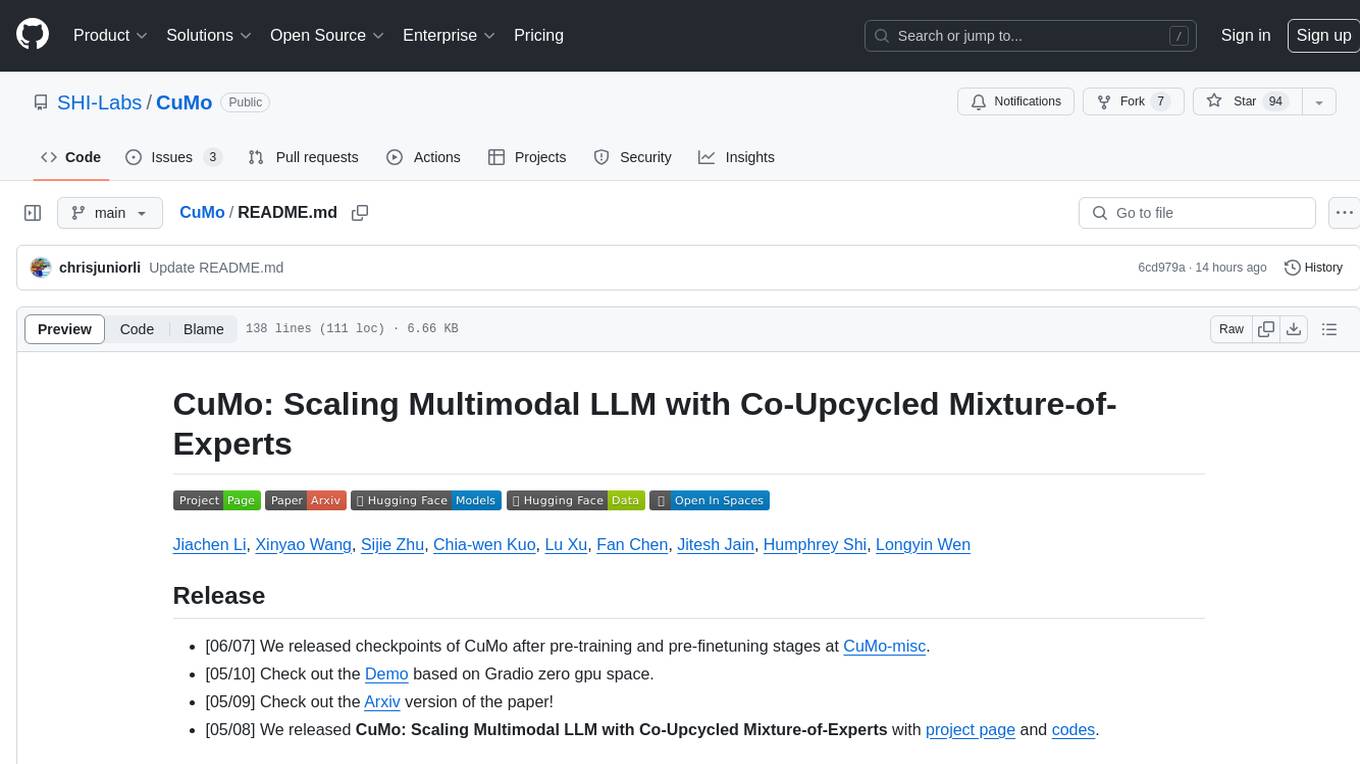
CuMo
CuMo is a project focused on scaling multimodal Large Language Models (LLMs) with Co-Upcycled Mixture-of-Experts. It introduces CuMo, which incorporates Co-upcycled Top-K sparsely-gated Mixture-of-experts blocks into the vision encoder and the MLP connector, enhancing the capabilities of multimodal LLMs. The project adopts a three-stage training approach with auxiliary losses to stabilize the training process and maintain a balanced loading of experts. CuMo achieves comparable performance to other state-of-the-art multimodal LLMs on various Visual Question Answering (VQA) and visual-instruction-following benchmarks.
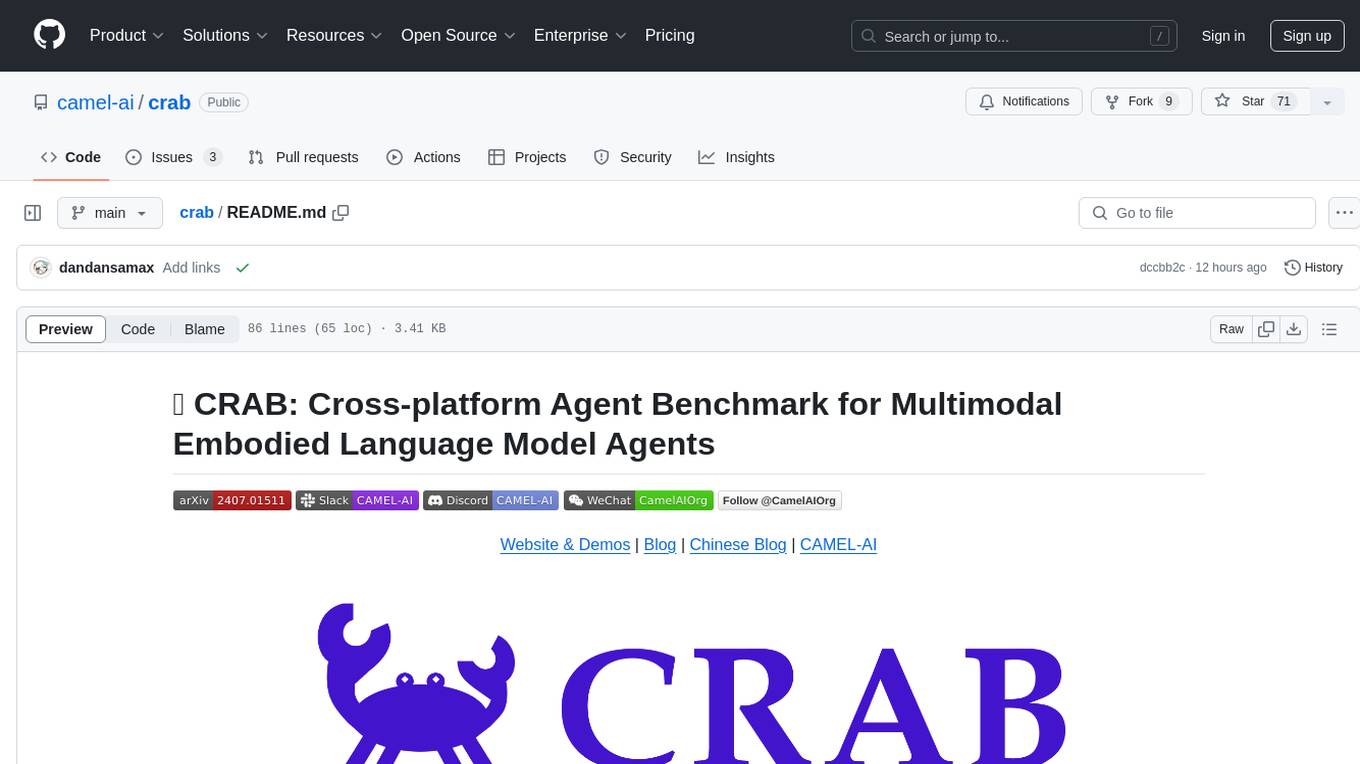
crab
CRAB is a framework for building LLM agent benchmark environments in a Python-centric way. It is cross-platform and multi-environment, allowing the creation of agent environments supporting various deployment options. The framework offers easy-to-use configuration with the ability to add new actions and define environments seamlessly. CRAB also provides a novel benchmarking suite with tasks and evaluators defined in Python, along with a unique graph evaluator method for detailed metrics.
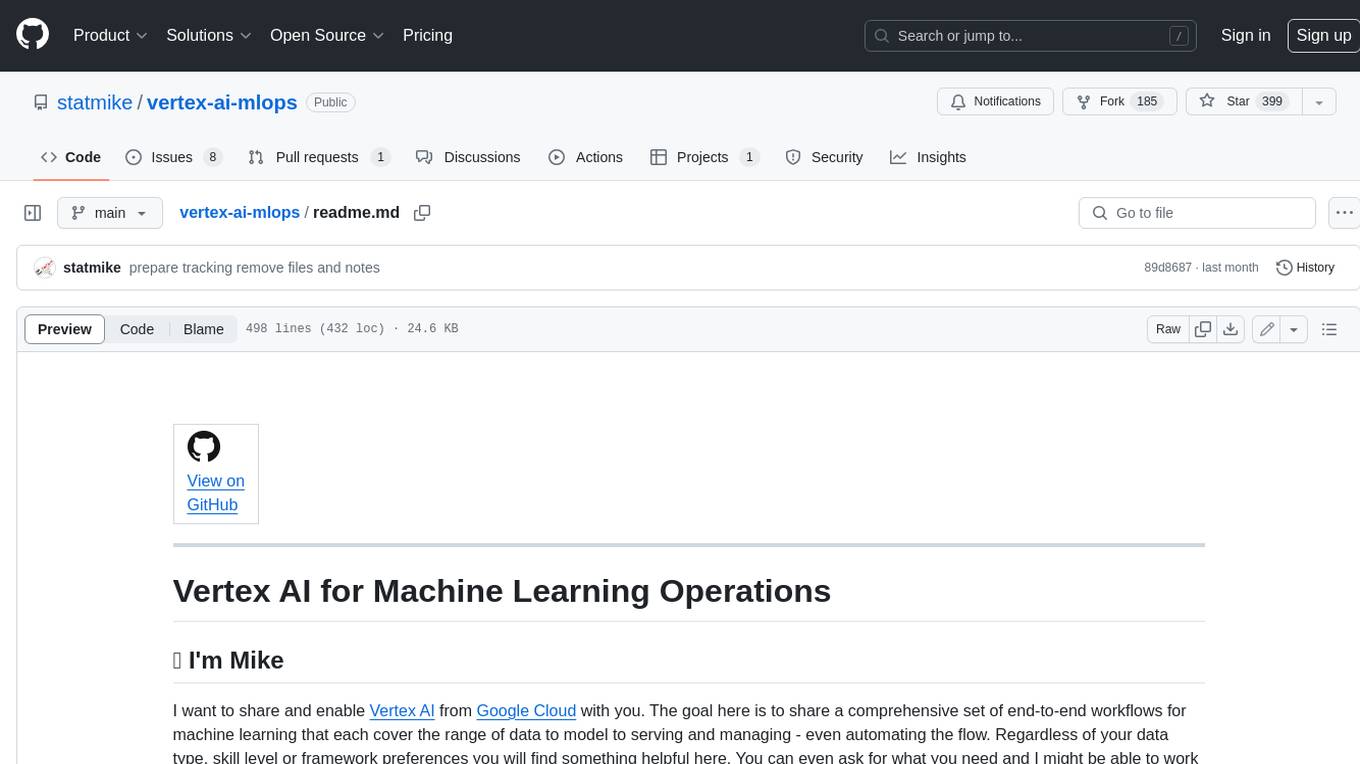
vertex-ai-mlops
Vertex AI is a platform for end-to-end model development. It consist of core components that make the processes of MLOps possible for design patterns of all types.
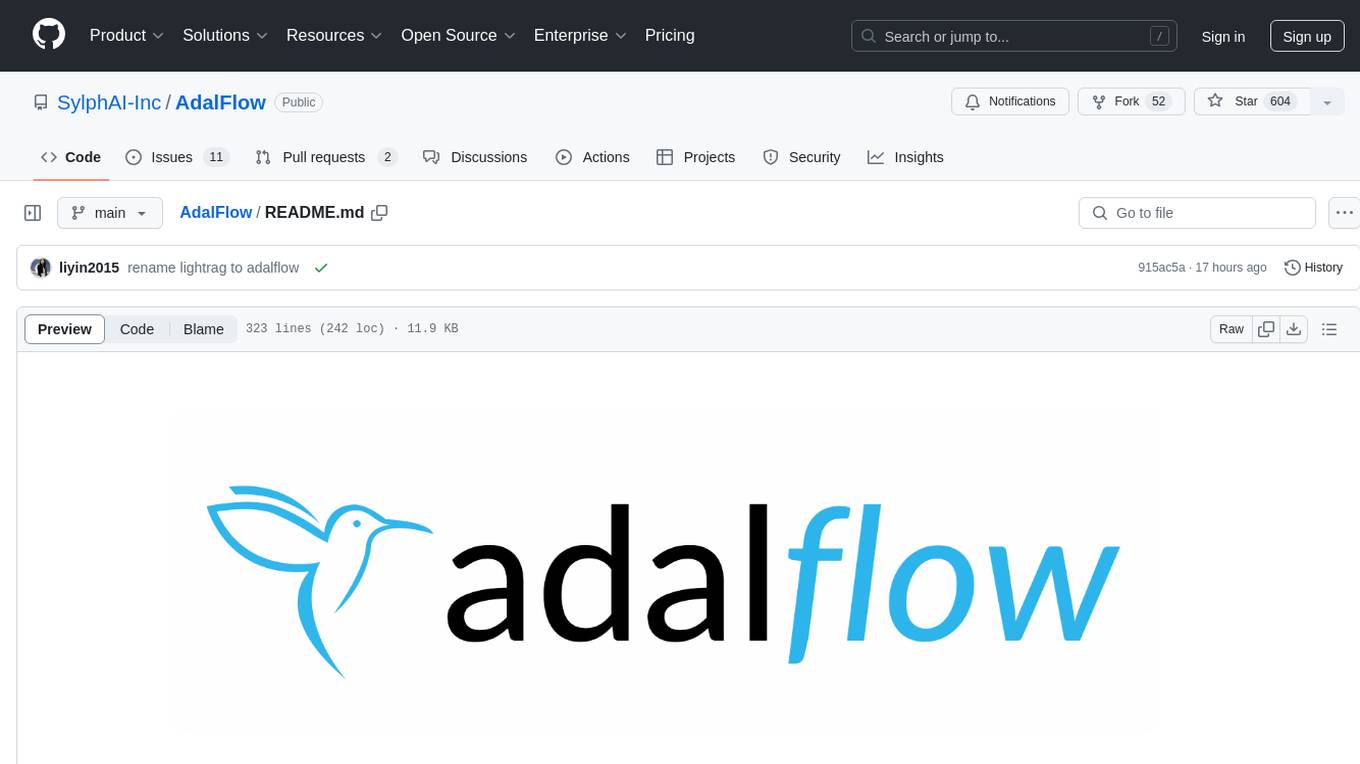
AdalFlow
AdalFlow is a library designed to help developers build and optimize Large Language Model (LLM) task pipelines. It follows a design pattern similar to PyTorch, offering a light, modular, and robust codebase. Named in honor of Ada Lovelace, AdalFlow aims to inspire more women to enter the AI field. The library is tailored for various GenAI applications like chatbots, translation, summarization, code generation, and autonomous agents, as well as classical NLP tasks such as text classification and named entity recognition. AdalFlow emphasizes modularity, robustness, and readability to support users in customizing and iterating code for their specific use cases.
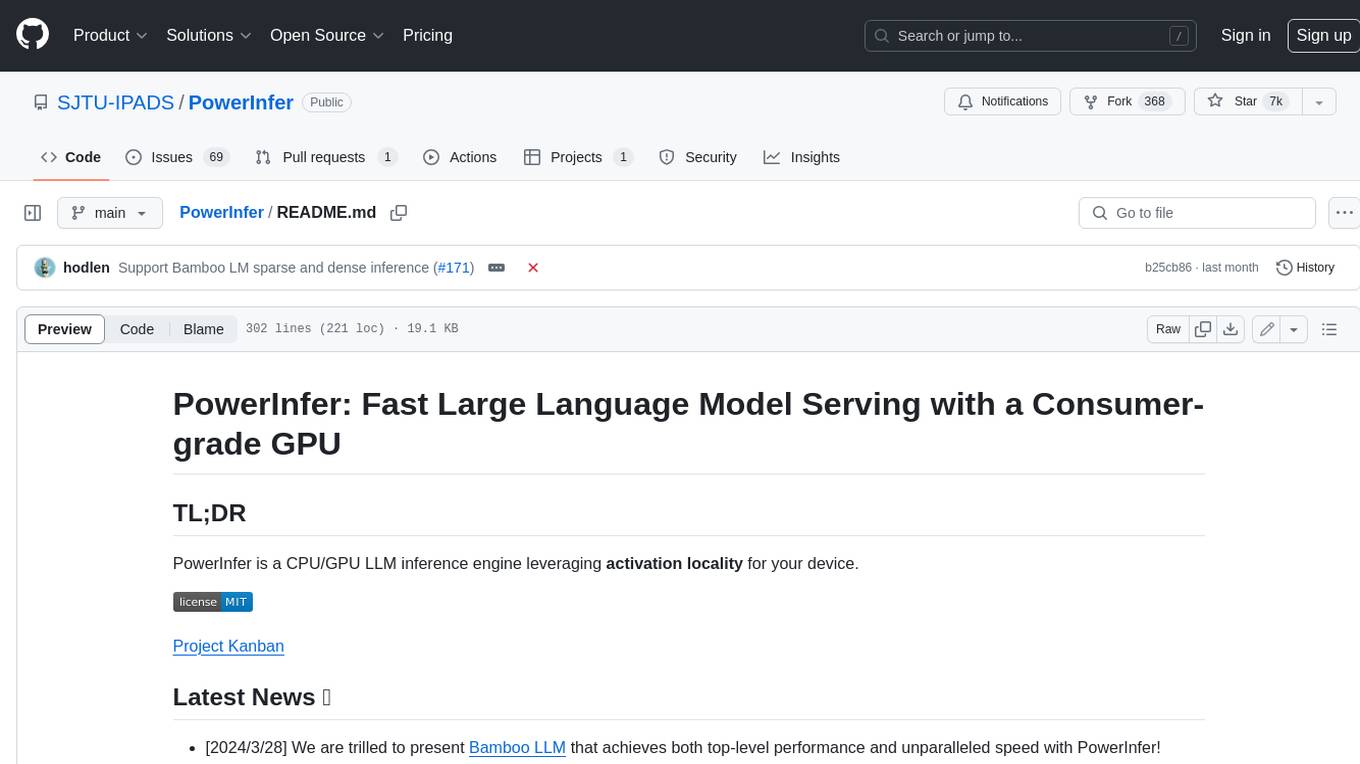
PowerInfer
PowerInfer is a high-speed Large Language Model (LLM) inference engine designed for local deployment on consumer-grade hardware, leveraging activation locality to optimize efficiency. It features a locality-centric design, hybrid CPU/GPU utilization, easy integration with popular ReLU-sparse models, and support for various platforms. PowerInfer achieves high speed with lower resource demands and is flexible for easy deployment and compatibility with existing models like Falcon-40B, Llama2 family, ProSparse Llama2 family, and Bamboo-7B.
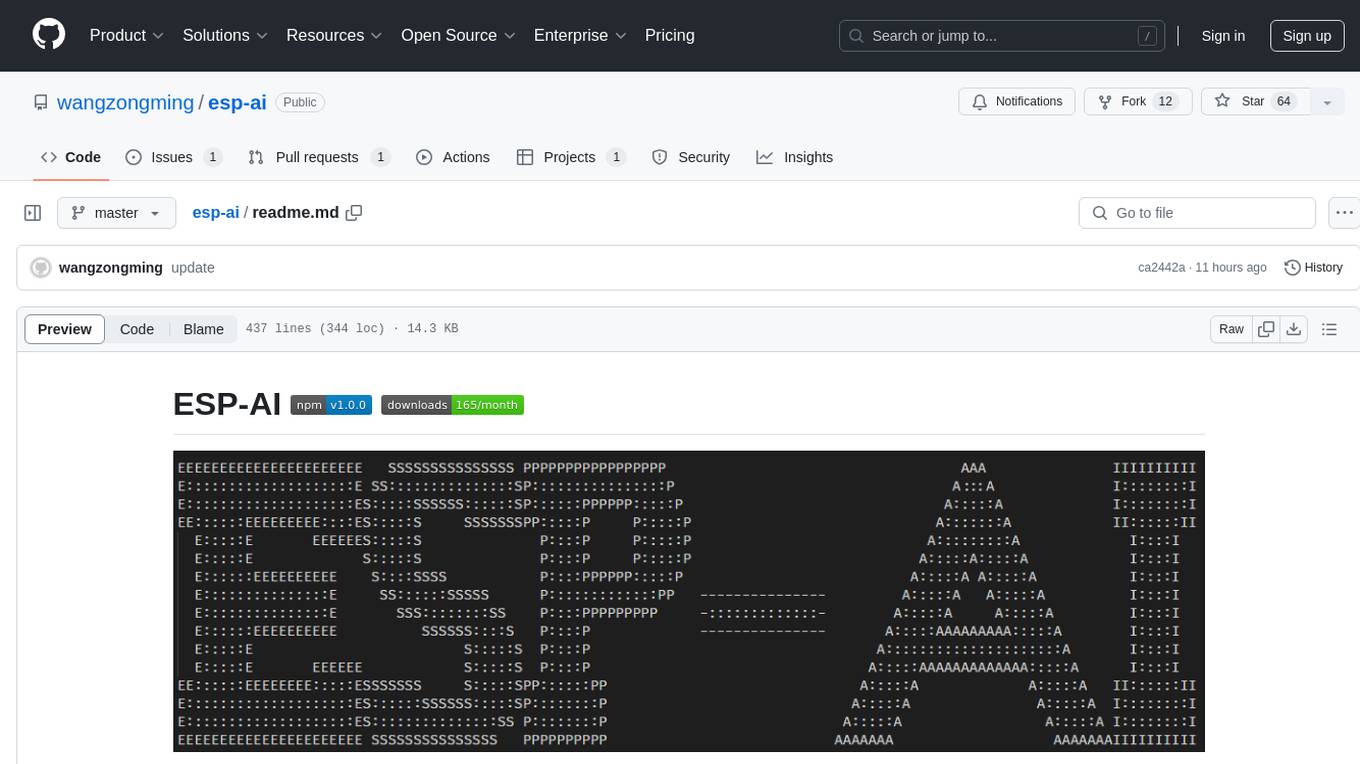
esp-ai
ESP-AI provides a complete AI conversation solution for your development board, including IAT+LLM+TTS integration solutions for ESP32 series development boards. It can be injected into projects without affecting existing ones. By providing keys from platforms like iFlytek, Jiling, and local services, you can run the services without worrying about interactions between services or between development boards and services. The project's server-side code is based on Node.js, and the hardware code is based on Arduino IDE.
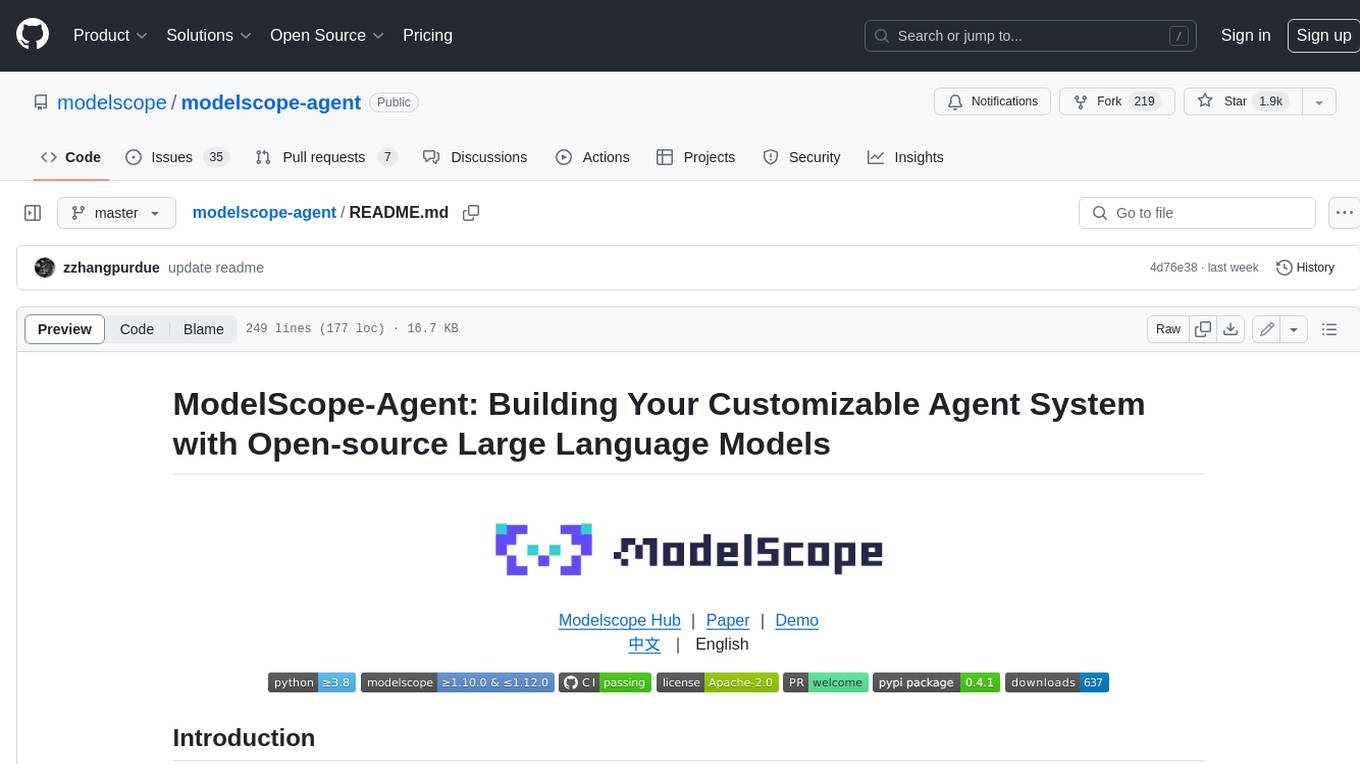
modelscope-agent
ModelScope-Agent is a customizable and scalable Agent framework. A single agent has abilities such as role-playing, LLM calling, tool usage, planning, and memory. It mainly has the following characteristics: - **Simple Agent Implementation Process**: Simply specify the role instruction, LLM name, and tool name list to implement an Agent application. The framework automatically arranges workflows for tool usage, planning, and memory. - **Rich models and tools**: The framework is equipped with rich LLM interfaces, such as Dashscope and Modelscope model interfaces, OpenAI model interfaces, etc. Built in rich tools, such as **code interpreter**, **weather query**, **text to image**, **web browsing**, etc., make it easy to customize exclusive agents. - **Unified interface and high scalability**: The framework has clear tools and LLM registration mechanism, making it convenient for users to expand more diverse Agent applications. - **Low coupling**: Developers can easily use built-in tools, LLM, memory, and other components without the need to bind higher-level agents.
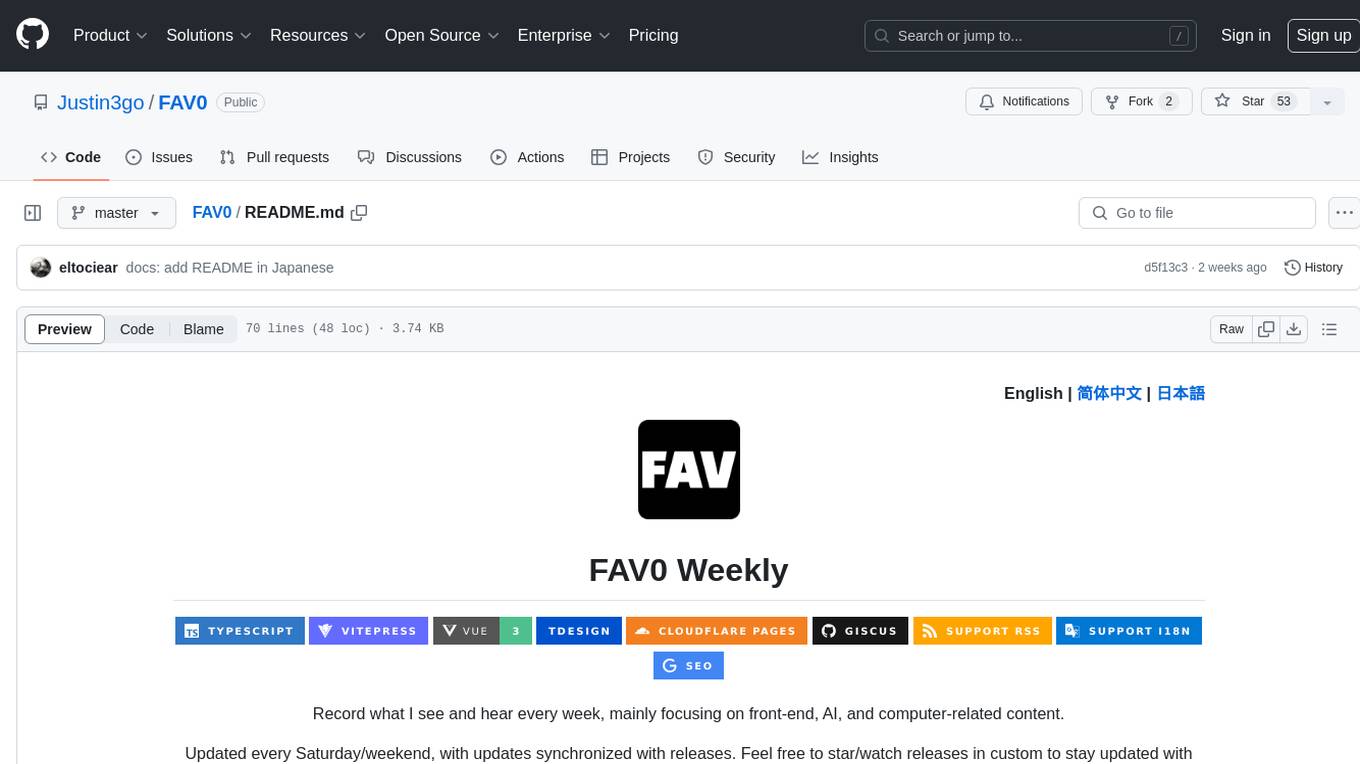
FAV0
FAV0 Weekly is a repository that records weekly updates on front-end, AI, and computer-related content. It provides light and dark mode switching, bilingual interface, RSS subscription function, Giscus comment system, high-definition image preview, font settings customization, and SEO optimization. Users can stay updated with the latest weekly releases by starring/watching the repository. The repository is dual-licensed under the MIT License and CC-BY-4.0 License.
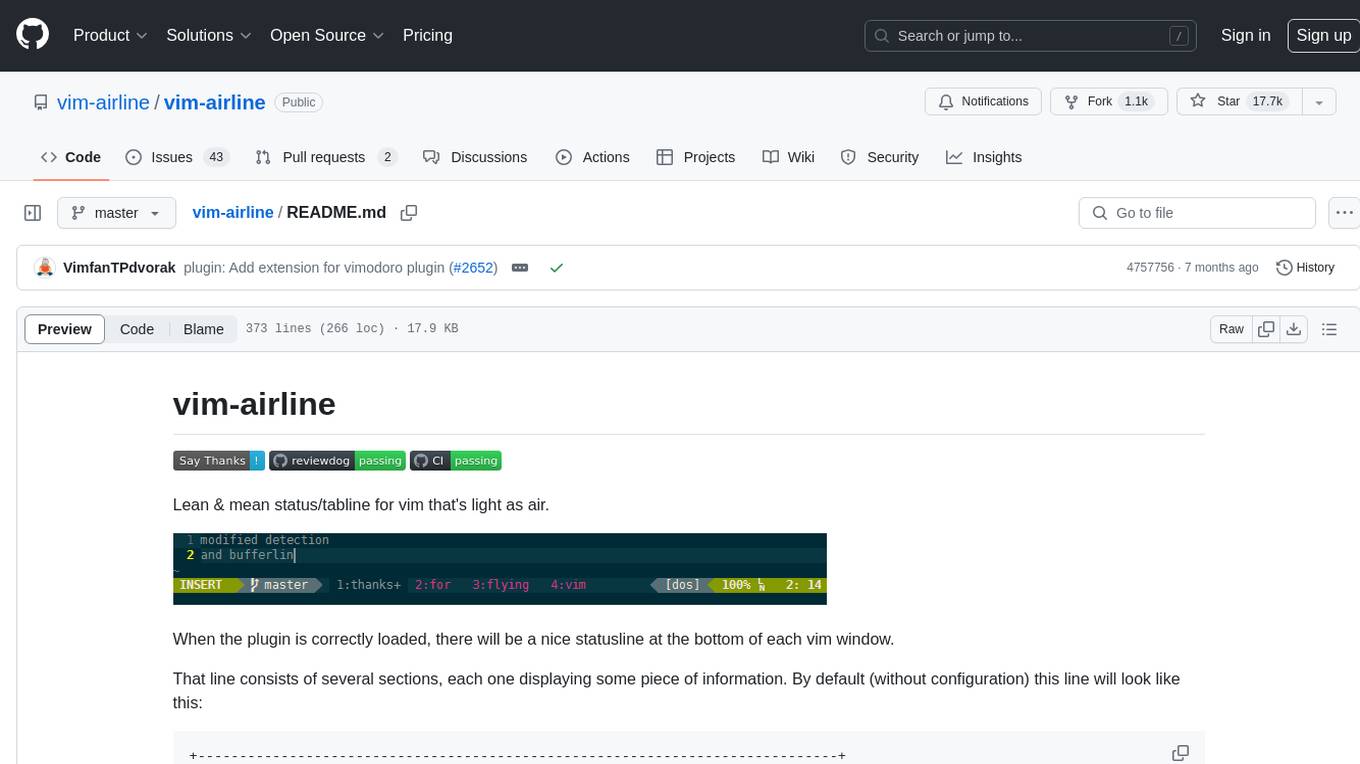
vim-airline
Vim-airline is a lean and mean status/tabline plugin for Vim that provides a nice statusline at the bottom of each Vim window. It consists of several sections displaying information such as mode, environment status, filename, filetype, file encoding, and current position in the file. The plugin is highly customizable and integrates with various plugins, providing a tiny core with extensibility in mind. It is optimized for speed, supports multiple themes, and integrates seamlessly with other plugins. Vim-airline is written in 100% Vimscript, eliminating the need for Python. The plugin aims to be stable and includes a unit testing suite for reliability.
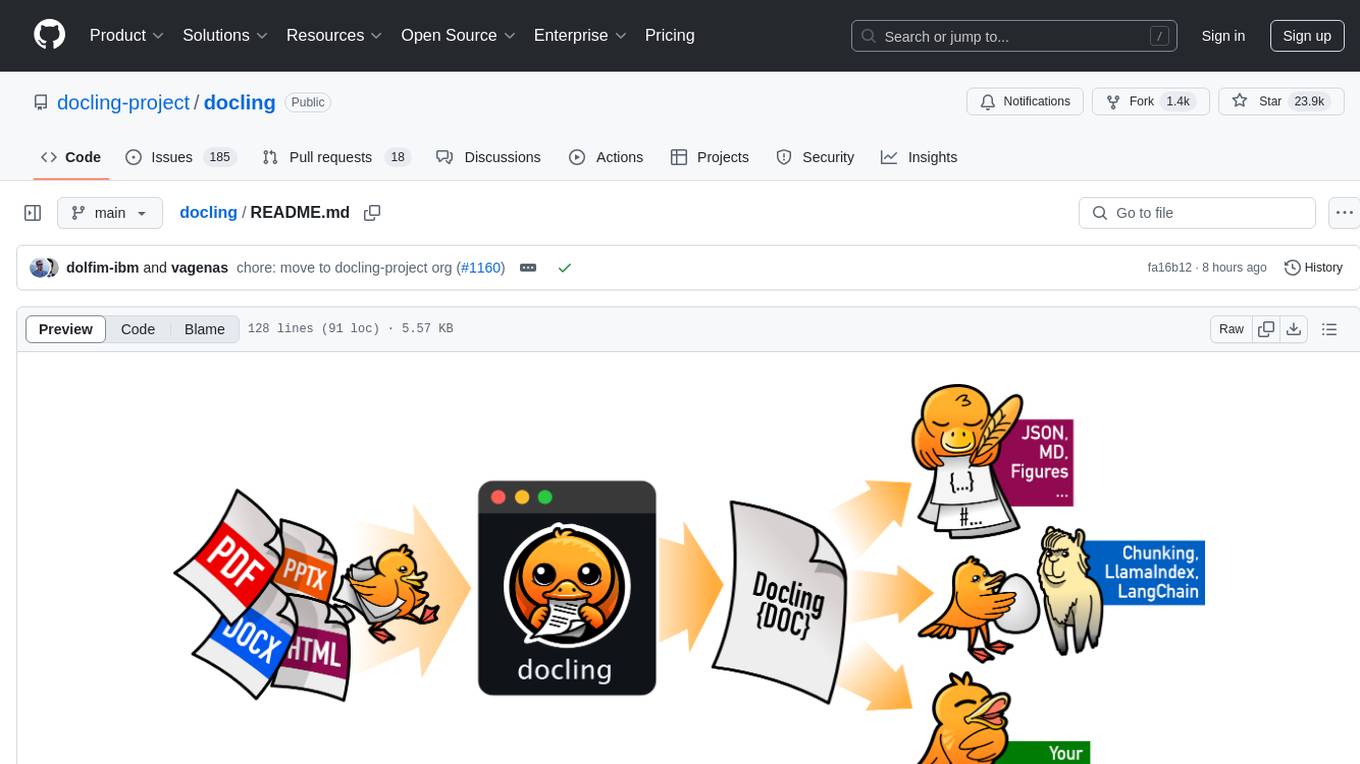
docling
Docling simplifies document processing, parsing diverse formats including advanced PDF understanding, and providing seamless integrations with the general AI ecosystem. It offers features such as parsing multiple document formats, advanced PDF understanding, unified DoclingDocument representation format, various export formats, local execution capabilities, plug-and-play integrations with agentic AI tools, extensive OCR support, and a simple CLI. Coming soon features include metadata extraction, visual language models, chart understanding, and complex chemistry understanding. Docling is installed via pip and works on macOS, Linux, and Windows environments. It provides detailed documentation, examples, integrations with popular frameworks, and support through the discussion section. The codebase is under the MIT license and has been developed by IBM.
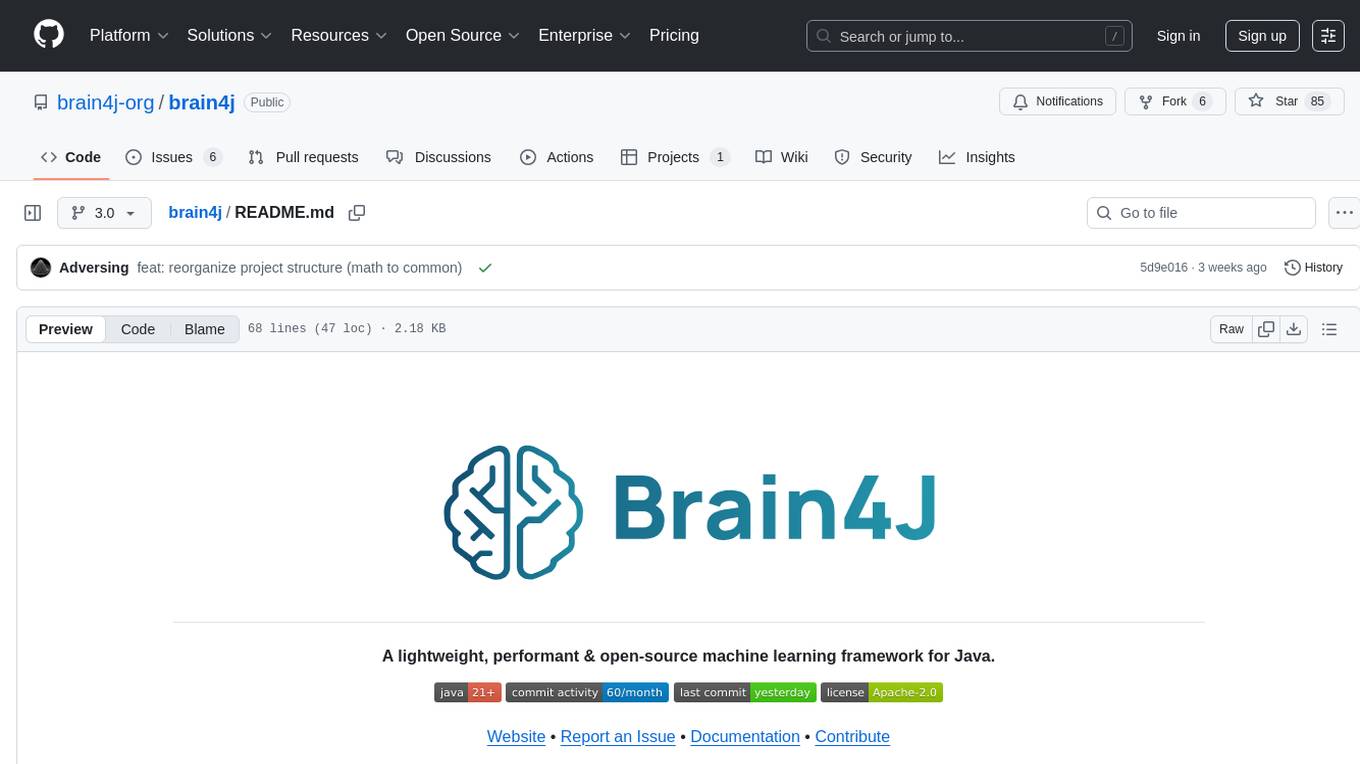
brain4j
Brain4J is a lightweight, performant, and open-source machine learning framework for Java. Designed with portability and speed in mind, it is optimized for high performance and ideal for those looking to implement machine learning solutions in pure Java. The framework provides tools and functionalities to facilitate the development of machine learning models within Java applications, offering ease of use and efficiency.
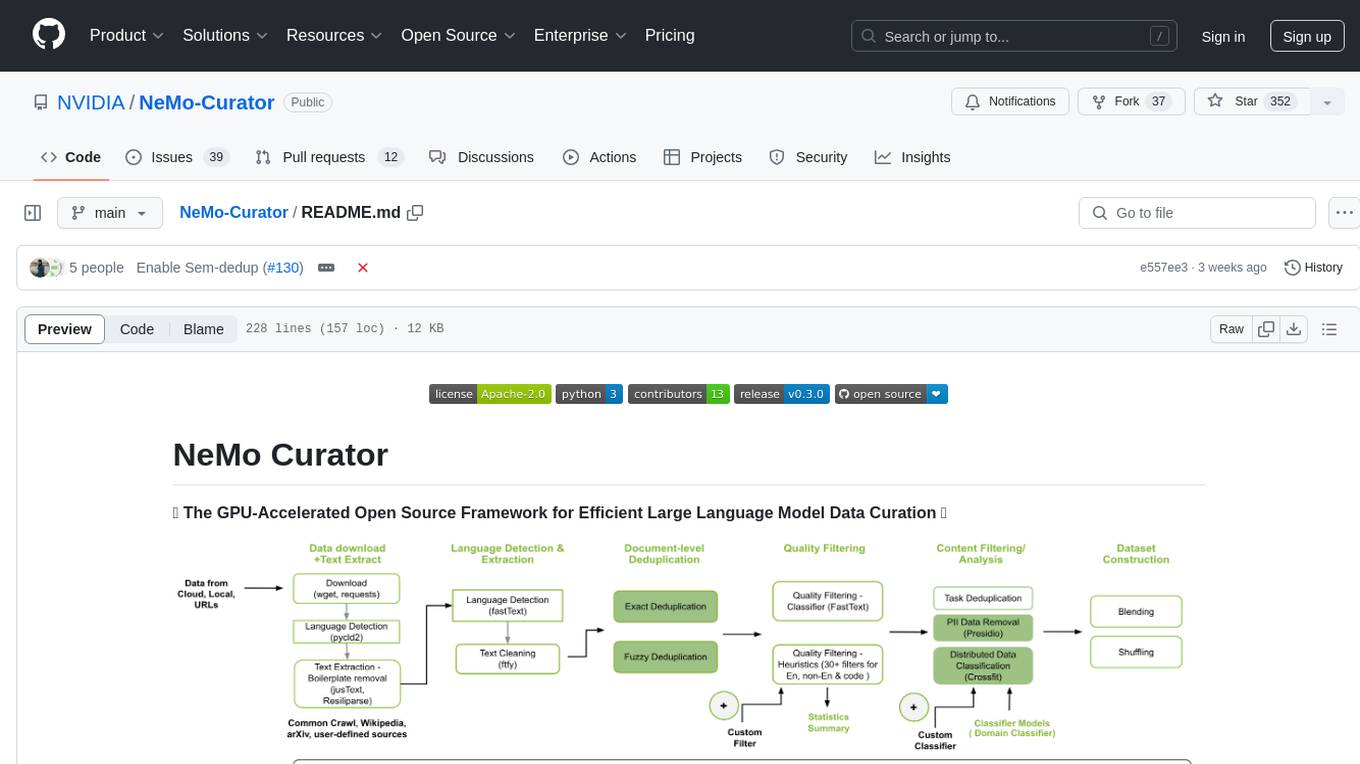
NeMo-Curator
NeMo Curator is a GPU-accelerated open-source framework designed for efficient large language model data curation. It provides scalable dataset preparation for tasks like foundation model pretraining, domain-adaptive pretraining, supervised fine-tuning, and parameter-efficient fine-tuning. The library leverages GPUs with Dask and RAPIDS to accelerate data curation, offering customizable and modular interfaces for pipeline expansion and model convergence. Key features include data download, text extraction, quality filtering, deduplication, downstream-task decontamination, distributed data classification, and PII redaction. NeMo Curator is suitable for curating high-quality datasets for large language model training.
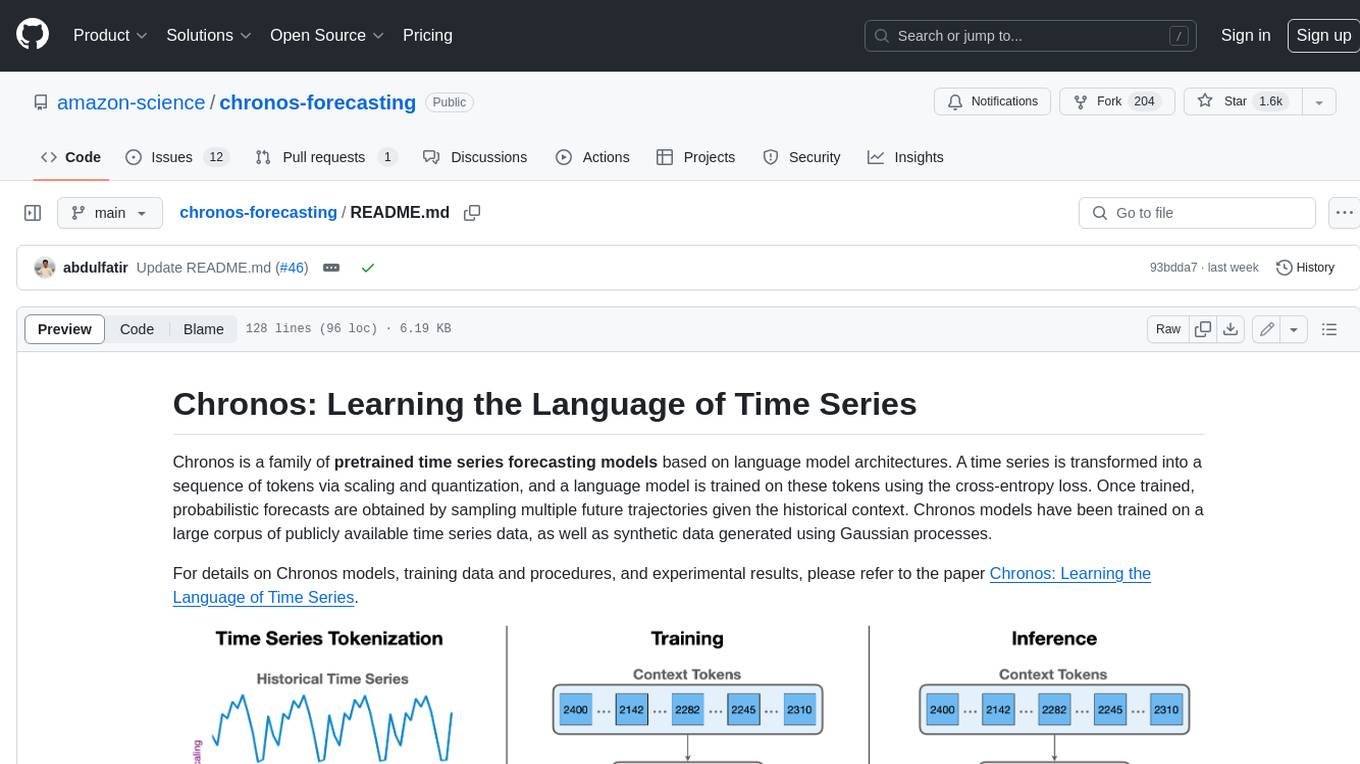
chronos-forecasting
Chronos is a family of pretrained time series forecasting models based on language model architectures. A time series is transformed into a sequence of tokens via scaling and quantization, and a language model is trained on these tokens using the cross-entropy loss. Once trained, probabilistic forecasts are obtained by sampling multiple future trajectories given the historical context. Chronos models have been trained on a large corpus of publicly available time series data, as well as synthetic data generated using Gaussian processes.
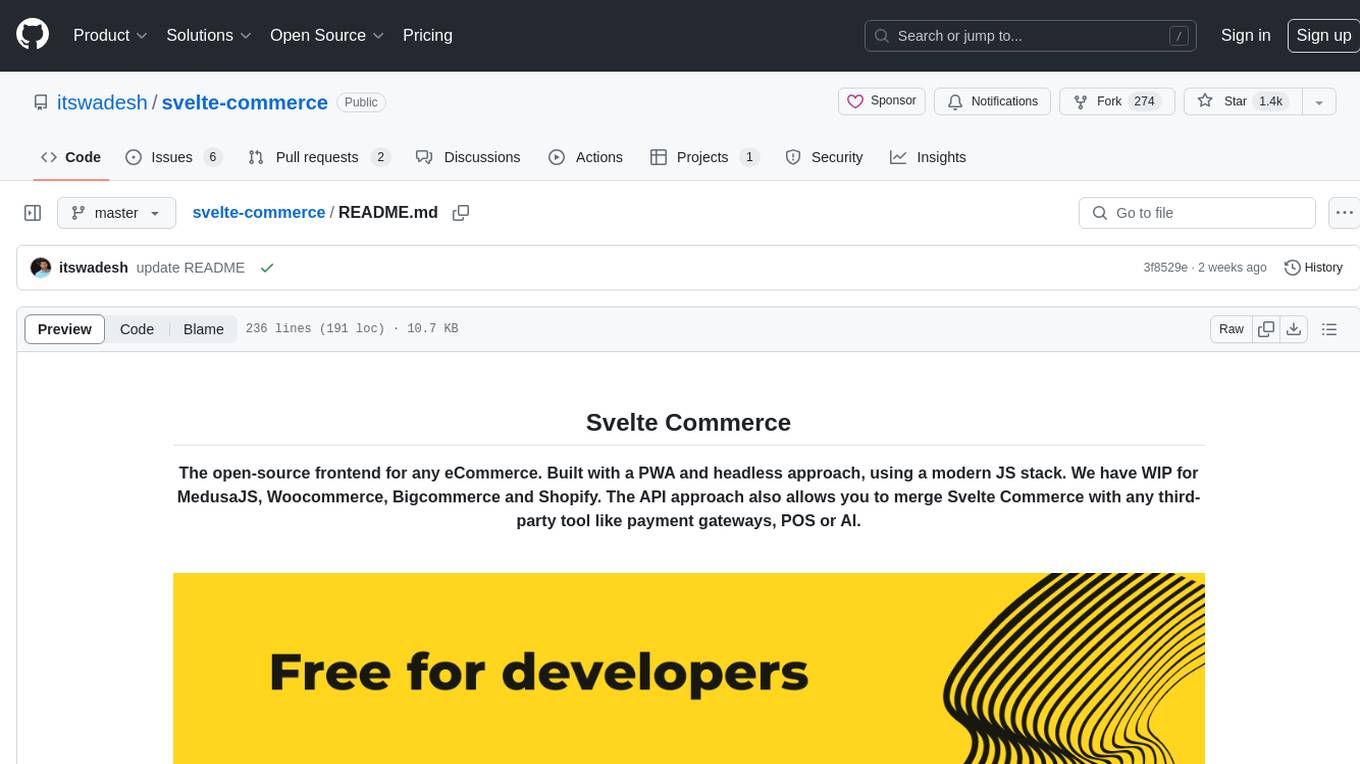
svelte-commerce
Svelte Commerce is an open-source frontend for eCommerce, utilizing a PWA and headless approach with a modern JS stack. It supports integration with various eCommerce backends like MedusaJS, Woocommerce, Bigcommerce, and Shopify. The API flexibility allows seamless connection with third-party tools such as payment gateways, POS systems, and AI services. Svelte Commerce offers essential eCommerce features, is both SSR and SPA, superfast, and free to download and modify. Users can easily deploy it on Netlify or Vercel with zero configuration. The tool provides features like headless commerce, authentication, cart & checkout, TailwindCSS styling, server-side rendering, proxy + API integration, animations, lazy loading, search functionality, faceted filters, and more.
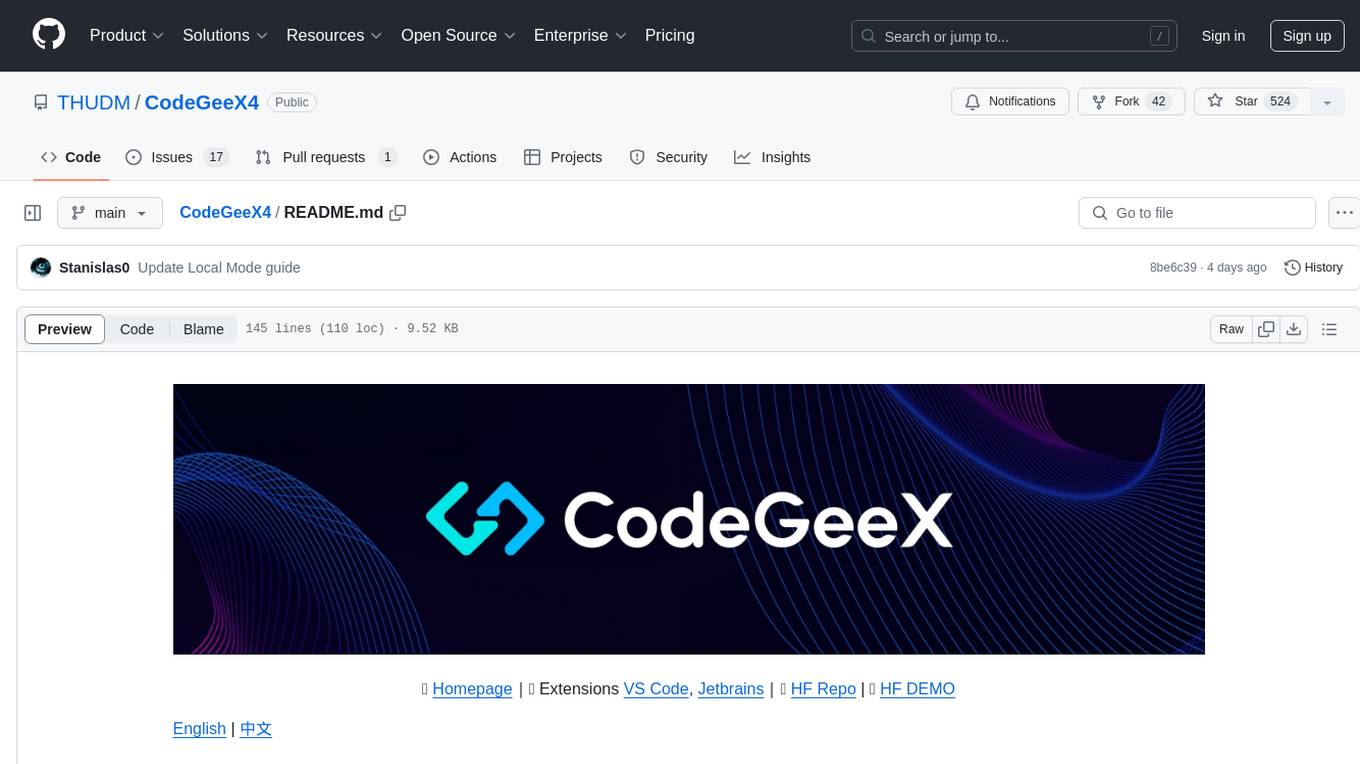
CodeGeeX4
CodeGeeX4-ALL-9B is an open-source multilingual code generation model based on GLM-4-9B, offering enhanced code generation capabilities. It supports functions like code completion, code interpreter, web search, function call, and repository-level code Q&A. The model has competitive performance on benchmarks like BigCodeBench and NaturalCodeBench, outperforming larger models in terms of speed and performance.
For similar tasks

EmbodiedScan
EmbodiedScan is a holistic multi-modal 3D perception suite designed for embodied AI. It introduces a multi-modal, ego-centric 3D perception dataset and benchmark for holistic 3D scene understanding. The dataset includes over 5k scans with 1M ego-centric RGB-D views, 1M language prompts, 160k 3D-oriented boxes spanning 760 categories, and dense semantic occupancy with 80 common categories. The suite includes a baseline framework named Embodied Perceptron, capable of processing multi-modal inputs for 3D perception tasks and language-grounded tasks.
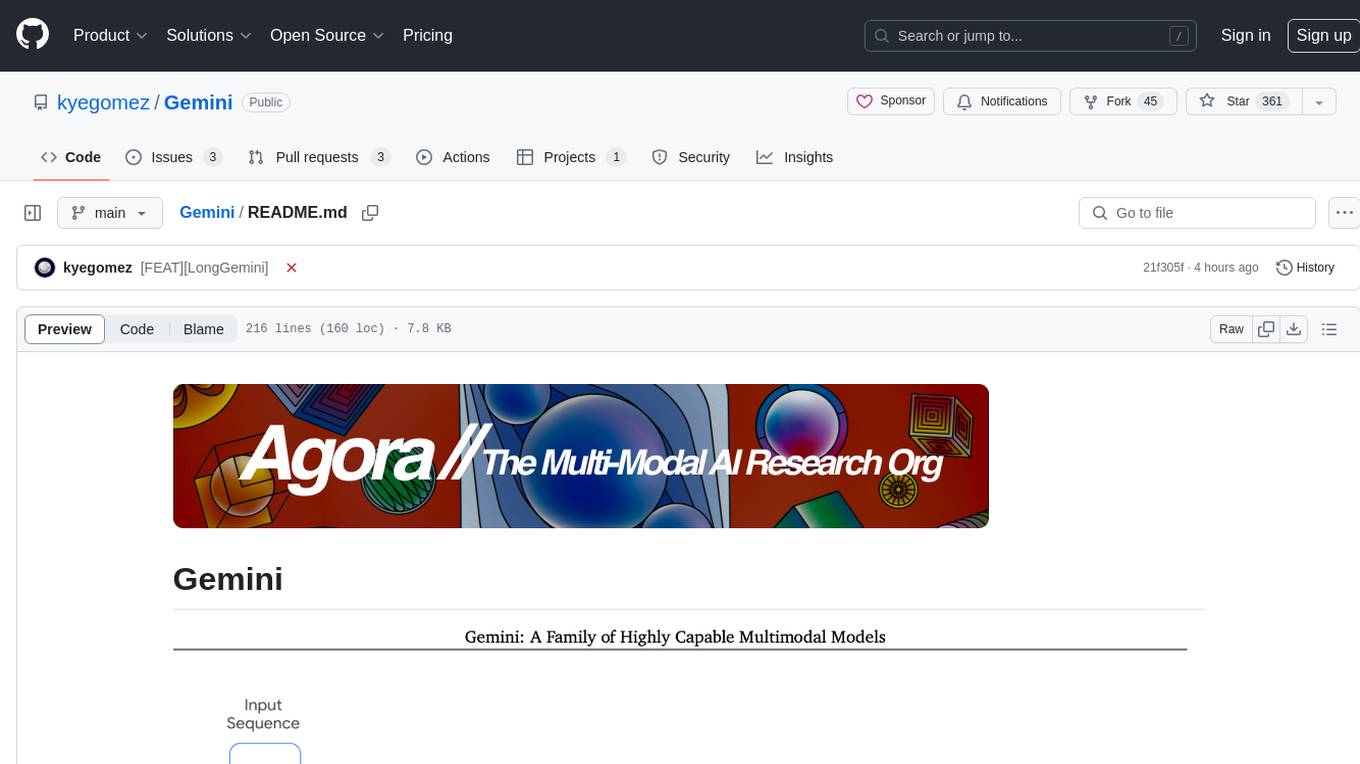
Gemini
Gemini is an open-source model designed to handle multiple modalities such as text, audio, images, and videos. It utilizes a transformer architecture with special decoders for text and image generation. The model processes input sequences by transforming them into tokens and then decoding them to generate image outputs. Gemini differs from other models by directly feeding image embeddings into the transformer instead of using a visual transformer encoder. The model also includes a component called Codi for conditional generation. Gemini aims to effectively integrate image, audio, and video embeddings to enhance its performance.
For similar jobs

weave
Weave is a toolkit for developing Generative AI applications, built by Weights & Biases. With Weave, you can log and debug language model inputs, outputs, and traces; build rigorous, apples-to-apples evaluations for language model use cases; and organize all the information generated across the LLM workflow, from experimentation to evaluations to production. Weave aims to bring rigor, best-practices, and composability to the inherently experimental process of developing Generative AI software, without introducing cognitive overhead.

LLMStack
LLMStack is a no-code platform for building generative AI agents, workflows, and chatbots. It allows users to connect their own data, internal tools, and GPT-powered models without any coding experience. LLMStack can be deployed to the cloud or on-premise and can be accessed via HTTP API or triggered from Slack or Discord.

VisionCraft
The VisionCraft API is a free API for using over 100 different AI models. From images to sound.

kaito
Kaito is an operator that automates the AI/ML inference model deployment in a Kubernetes cluster. It manages large model files using container images, avoids tuning deployment parameters to fit GPU hardware by providing preset configurations, auto-provisions GPU nodes based on model requirements, and hosts large model images in the public Microsoft Container Registry (MCR) if the license allows. Using Kaito, the workflow of onboarding large AI inference models in Kubernetes is largely simplified.

PyRIT
PyRIT is an open access automation framework designed to empower security professionals and ML engineers to red team foundation models and their applications. It automates AI Red Teaming tasks to allow operators to focus on more complicated and time-consuming tasks and can also identify security harms such as misuse (e.g., malware generation, jailbreaking), and privacy harms (e.g., identity theft). The goal is to allow researchers to have a baseline of how well their model and entire inference pipeline is doing against different harm categories and to be able to compare that baseline to future iterations of their model. This allows them to have empirical data on how well their model is doing today, and detect any degradation of performance based on future improvements.

tabby
Tabby is a self-hosted AI coding assistant, offering an open-source and on-premises alternative to GitHub Copilot. It boasts several key features: * Self-contained, with no need for a DBMS or cloud service. * OpenAPI interface, easy to integrate with existing infrastructure (e.g Cloud IDE). * Supports consumer-grade GPUs.

spear
SPEAR (Simulator for Photorealistic Embodied AI Research) is a powerful tool for training embodied agents. It features 300 unique virtual indoor environments with 2,566 unique rooms and 17,234 unique objects that can be manipulated individually. Each environment is designed by a professional artist and features detailed geometry, photorealistic materials, and a unique floor plan and object layout. SPEAR is implemented as Unreal Engine assets and provides an OpenAI Gym interface for interacting with the environments via Python.

Magick
Magick is a groundbreaking visual AIDE (Artificial Intelligence Development Environment) for no-code data pipelines and multimodal agents. Magick can connect to other services and comes with nodes and templates well-suited for intelligent agents, chatbots, complex reasoning systems and realistic characters.


